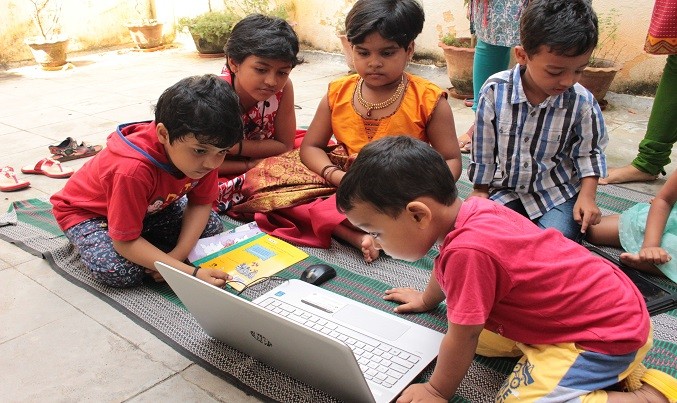One Indian non-profit is trying to make policymakers adopt captioning as a one-stone-two-birds solution: for literacy and accessibility. It might just happen, reports Meera Rajagopalan.
Twenty-five years ago, we accessed television through an antenna that had a mind of its own. When the signal was unclear, we had to go to the terrace and rotate the antenna until the picture appeared on the television set. It was a small tweak, but it made all the difference.
Sometimes, the most impactful technologies can be the ones that are like the turning of the antenna—tweaks to already existing infrastructure.
According to Brij Kothari, founder and director of Indian non-profit PlanetRead, there is an existing technology that has the potential to be that tweak that will help two billion people with reading literacy: Same Language Subtitling (SLS).
Kothari says that SLS, the display of captions, preferably synchronous, like karaoke, with audio on the screen, has the potential to change the learning landscape of the country’s literacy, along with helping those with hearing impairments.
Kothari’s campaign has recently received a shot in the arm with the September 11 Indian government’s announcement that accessibility standards for TV programmes will be implemented in a phased manner. The policy calls for 50% of all television programming to be captioned by the year 2025, excluding a few categories such as news, live sports, and reality shows. This move comes on the heels of the Rights of Persons with Disabilities Act.
That Kothari’s 23-year-long campaign might finally see light at the end of the tunnel also underlines the importance of cross-cause collaboration.
Arman Ali, disability rights activist and executive director of National Centre for Promotion of Employment for Disabled People (NCPEDP), says, “It has been proven time and again that disability rights are not limited to Persons with Disabilities alone, their implementation allows smooth functioning for people in general.” He cites ramps, which give better access to senior citizens, pregnant women, and even shoppers pushing a cart. However, his group does not push for open captioning.
Atul Kumar Tiwari, additional secretary, Ministry of Information and Broadcasting, Government of India, says that they wanted to go ahead and implement the standards, with a review every two years, so that a start is made.
“The idea is that even if it is not totally as it should be, we should make a beginning somewhere,” Tiwari says. The ministry held several rounds of deliberations with various stakeholders, including private broadcasters, whose concerns were on cost and personnel implications.
“It was not easy for the ministry to bring a balance in interests between the two (broadcasters and disability rights). We were, however, guided by the fact that the same broadcasters, when they broadcast their programmes abroad, used subtitles. So it was a mental, rather than a real difficulty for some of them,” Tiwari says.
It might, however, be a case of so-near-yet-so-far, as channels may decide to go in for closed captioning, which can be turned on and off. Kothari is cautiously optimistic, and while lauding the move, also fears that closed captions will not help reap the literacy benefits that he advocates.
Sony Pictures Networks India has, in fact, introduced closed captioning for some of its programs and has plans to expand the closed captioning, not open captioning.
“Policy will continue to have a major monitoring role to ensure compliance,” says Kothari, adding, “The effect on literacy will be clear within a year if at least 20-30 films a week in any given language, are telecast with open captions or SLS of the dialog and songs.”
Ali adds his concerns. “It's imperative when media accessibility is talked about, it should cover people with various disabilities. Accessibility cannot be limited to just virtual/cinematic experience; it should ensure a barrier-free environment to information and theatres,” he says.
“Will result in more reading than is happening in the country today.”
Just adding SLS to programs, Kothari says, will create a literacy effect greater than all the efforts put in by civil society and the government. With the average Indian estimated to watch more than 3 hours and 45 minutes of television a day, the opportunity for impact seems huge.
“It (SLS) will provide three hours of reading per day per person, that’s more than all the reading that is happening in the country today,” he says.
PlanetRead has enough evidence to prove that SLS improves literacy. From its first study in 1996, an informal study where two televisions were placed in a railway station, one with subtitles and one without (people preferred the television with subtitles), to a 2015 study following two years of SLS on all movies telecast on a particular channel (30.5% of children improved reading skills in SLS group, compared to 2.1% in non-SLS group ).
While PlanetRead conducted several studies, over the years, all of them demonstrating considerable impact, the idea was not taken up by policymakers on a sustained basis. Government broadcaster Doordarshan’s film songs program, Rangoli, added SLS for seven years, enabling a longitudinal study for PlanetRead. Yet, convincing authorities seemed to be a tall order.
Subtitle campaigns go international
The studies, however, did not go in vain, as campaigns such as the United Kingdom’s Turn on the Subtitles, have used it to advocate mandatory turning on of subtitles.
Started by friends Henry Warren and Oli Barrett, the Turn On The Subtitles campaign aims to get broadcasters, policymakers, and parents to turn on the subtitles. They say subtitling is “an idea whose time has come. Extensive research across multiple countries has shown us a way to improve children’s literacy. It’s incredibly simple; just turn on the subtitles.”
“But the West, they are much ahead of us, because they already have captions. It’s only a matter of what the default is,” says Kothari.
In fact, it was in 1996, watching a Spanish film, that Kothari chanced upon the idea. Because he was learning Spanish, while a student at Cornell University, U.S., he wished the closed captions of the film were in Spanish, instead of in English, so he could better learn the language. Extrapolating the idea, it became clear that mandatory captioning could be useful not just for language learning, but also for literacy, apart from its obvious application in inclusive media.
In fact, the goal of language learning is what prompted Kothari’s other initiative: BookBox (see “Thinking outside the box”).
While SLS helps with three goals—rights of PwDs, literacy, and language learning—the slow pace of its adoption calls into question the factors influencing policy, says Kothari.
“Often, for innovators, it is a waiting game. There is also a reluctance to accept science, and evidence-based policy-making is not happening in India,” he says. He says the challenge was always to move things up, because innovations are usually not the domain of one ministry, and ministries tend to lob the ball over to their colleagues, rather than take ownership of an idea or innovation. For instance, subtitles will have to also be taken up with digital content, something that falls under the purview of the Information and Technology department.
PlanetRead received the 2013 Library of Congress Literacy Award, and was funded by the World Bank’s Global Innovation Fund. None of that has helped him crack the most crucial piece of the puzzle until now: government policy.
“SLS is a great opportunity for India,” says Kothari. “They (the government) could actually advance this as an innovation for other countries, as India’s contribution to solving the literacy problem around the world.”
– end –
Thinking outside the box
PlanetRead’s other initiative: BookBox, addresses a different problem in literacy: Indian language literacy. BookBox is now a repository of freely available YouTube videos with animated films, subtitled, in little-known Indian languages like Bhili, and Santali, in addition to more popular Indian and international languages, from Dutch to Swahili. “Indian children do not have access to literature in their language,” Kothari says, apart from, perhaps in a few major languages.
With over 400,000 subscribers, BookBox publishes stories with animations, with captions and audio in various languages.











